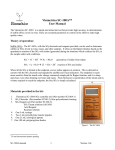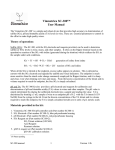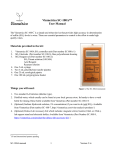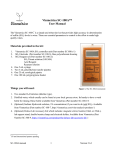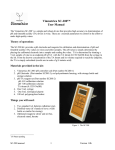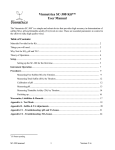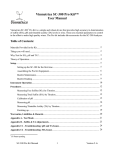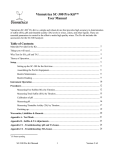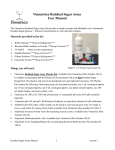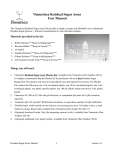Download Vinmetrica SC-100™ User Manual
Transcript
Vinmetrica SC-100™ User Manual The Vinmetrica SC-100* is a simple and robust device that provides high accuracy in determination of free and total sulfite (SO2) levels in wine. Based on the reliable and widely-used Ripper titration method, the SC-100’s amperometric principle allows trouble-free detection of the endpoint in wine and musts, red or white. Theory of operation: The Ripper titration is based on the quantitative reaction of the SO2 with iodine (generated during the titration) which oxidizes the SO2 in the sample under acid conditions. IO3- + 5I- + 6H+ 3I2 + 3H2O generation of iodine from iodate SO2 + I2 + H2O 2I- + SO3 + 2H+ reaction of SO2 and iodine When all the SO2 is titrated at the endpoint, excess iodine appears in solution. This is detected as current with the electrode and signaled by audible and visual indicators. The endpoint is much more sensitive than the starch color change commonly employed for Ripper titration, and it is sharp and clear, even when titrating red wines and musts. From the known concentration of the titrant and its volume required to reach the endpoint, the free SO2 is simply calculated. Materials provided in the kit: 1. 2. 3. 4. 5. 6. 7. 8. Vinmetrica SC-100 SO2 controller unit (Part number SC100-1) Electrode (Part number SC100-3) 9V battery Reagent set (Part number SC100-2) a) Titrant solution (0.0156N) b) Acid Reagent c) Reactant solution One 5 mL syringe Two 3-ml polyethylene transfer pipettes One 25 mL serological pipette 100 mL polypropylene beaker * US Patent pending SC-100 manual 1 Version 2.5c Things you will need: 1. Distilled water (it’s handy to have a wash bottle or similar for rinsing) 2. (Optional) magnetic stirrer and stir bar, electrode stand, burette 3. (Optional) Sodium Hydroxide solution, 1N concentration (if you want to do total SO2). Available from Vinmetrica (Part number SC100-7). Figure 1. The SC-100 instrument. Setting up the instrument: 1. The SC-100 (Figure 1) runs on a standard 9V battery. Open the battery housing on the bottom of the unit and attach the 9V battery, then close the housing. 2. Attach the electrode via the BNC connector at the back. Remove any protective cover from the electrode tip (some electrodes are shipped without one). Put the electrode on its side, or hang it from an electrode stand if you have one. Note: the electrode is sturdy with its plastic housing, but do take care not to let things touch or strike the platinum wires; they are somewhat fragile and will break if bent and straightened repeatedly. Electrode care: when done, always rinse with DI water and let air dry. There is no need to store the electrode in any kind of solution. 3. Turn on the instrument by pressing the Power button. You should see the display show a value less than 1.00 and the green (Proceed) LED should be on. Be sure to check the battery by briefly holding down the Battery Check button; the LCD display will show the battery voltage and the LEDs will indicate good (green) or bad (red). Replace the battery if bad. SC-100 manual 2 Version 2.5c Titration procedures: Free SO2 1. Fill the syringe by drawing up the Titrant. Expel bubbles and set the plunger on the syringe to a readable point, preferably the 5.0 mL point. [Note: the 5.0 mL setting allows determination of up to 100 ppm SO2 in a standard 25 mL wine sample.] If you are using a buret instead, fill it now. 2. Place 25 mL wine or must in the titration vessel. We recommend using the 25 mL pipette provided in the kit: draw sample up to the 0 mL mark, then dispense the sample into your titration vessel by letting the tip of the pipette touch the side of the vessel while the sample drains. For best accuracy, do not blow out the liquid that remains in the tip. 3. Using the transfer pipettes, add about 2 mL Acid Reagent and 2 mL Reactant solution to the vessel. It is not necessary to be extremely accurate in this step; with these pipettes, 2 mL is roughly the amount that fills the bulb with a single thorough squeeze. Caution: the Acid reagent is corrosive and can cause damage to clothing, skin and eyes. The Reactant solution should not be ingested. We recommend use of laboratory safety glasses and latex or nitrile gloves during this procedure. If any solutions contact skin or eyes, flush with plenty of water. 4. If you are using a magnetic stirrer, turn it on to stir at a moderate rate. Be sure the stir bar will not strike the electrode in the next step. 5. Rinse the electrode briefly with distilled water. Insert the electrode into the titration vessel so that the tip is completely submerged to just above the circulation gaps (cutouts at the tip of the electrode). 6. If you are stirring manually, begin now; use a constant moderate swirling motion. If the electrode is not held in a stand, hold it against the side of the vessel with one finger and grasp the vessel with the remaining fingers so that the two move together. (Figure 2) SC-100 manual 3 Version 2.5c Figure 2. Manual stirring technique. Hold the electrode against the side of the vessel and swirl gently; add titrant with other hand. 7. Verify that the current is less than 3.0 and the green (“PROCEED”) LED is lit. If the current is greater than this, and/or the red (“STOP”) LED is lit and the buzzer sounds, your sample has less than 2 ppm SO2 and there is no need to proceed. 8. Titrate the sample by adding the Titrant dropwise from the syringe or buret, being sure to note the starting volume mark on the syringe or buret. Try to accomplish the titration as rapidly as possible (in 2 minutes or less), but be careful near the endpoint so as not to overrun it – here, dispense one or two drops at a time. Be sure to maintain stirring or swirling throughout the entire procedure. 9. During the titration, the LCD display will show transient currents, the red LED will briefly illuminate, and the buzzer will sound. These transient indicators will last longer and longer as you approach the endpoint, just as starch indicator does during a conventional titration. Take the endpoint as the first addition of Titrant that causes the display to maximize (approximately 4.5 or greater), and the red LED and buzzer to stay on, for longer than 15 seconds. It is important to maintain stirring or swirling to detect the endpoint well. Read the endpoint volume off of the syringe or buret. 10. The free SO2 content is calculated as ppm SO2 = 64 * V * N * 1000 2*S where V = mL Titrant needed to reach the endpoint; N = normality of the Titrant, S = mL sample. 1 If you use 25 mL of sample as directed, and the Titrant is 0.0156 N as supplied, then the calculation is simply ppm SO2 = 20 * V (i.e. 20 times V) For total SO2 1. Place 25 mL wine or must in the titration vessel. 2. Add 10ml 1N sodium hydroxide and mix well. Let stand approximately 10 minutes. 3. Using the transfer pipettes, add 8 mL Acid Reagent and 2 mL Reactant solution to the vessel. Remember that if you are using the transfer pipettes in the kit, 2 mL is the amount that fills the bulb with a vigorous squeeze, so dispense four of these for the Acid Reagent. 4. Proceed from step 4 in the Free SO2 procedure above. The result calculated will be total, rather than free, ppm SO2. 1 64 [mg SO2/mmol SO2 ]* V [mL] * N [meq/mL] * 1000 [mL/L] 2 [meq/mmol SO2] * S [mL] SC-100 manual 4 Version 2.5c Finish up: 1. Turn off the instrument. 2. Rinse the electrode and syringe with distilled water. Let air dry. 3. Discard waste samples and solutions in accordance with local regulations. Acidic solutions can be neutralized by slow addition of baking soda (sodium bicarbonate) with stirring until effervescence ceases. Technical assistance: [email protected] tel. 760-494-0597 WARRANTIES AND LIABILITIES 1. The materials provided in the kit, as described on page 1 above, (“Materials”) are warranted as follows: The SC-100 instrument, electrode and non-reagent accessories are warranted against defects in workmanship for 12 months from date of purchase. The reagents are warranted to perform as described herein up until any stated expiration date or 6 months after purchase, whichever is later. THE WARRANTIES IN THESE TERMS AND CONDITIONS ARE IN LIEU OF ALL OTHER WARRANTIES, EXPRESS OR IMPLIED, INCLUDING WITHOUT LIMITATION ANY WARRANTIES OF MERCHANTABILITY, NONINFRINGEMENT, OR FITNESS FOR A PARTICULAR PURPOSE, SAID WARRANTIES BEING EXPRESSLY DISCLAIMED. 2. Buyer agrees that its sole and exclusive remedy against Vinmetrica shall be limited to the repair and replacement of Materials or parts of Materials, provided Vinmetrica is promptly notified in writing, prior to the expiration of the warranty period specified above, of any defect. Vinmetrica’s liability for any damages due Buyer shall be limited to the purchase price of the Materials. 3. VINMETRICA'S MAXIMUM LIABILITY FOR ALL DIRECT DAMAGES, INCLUDING WITHOUT LIMITATION CONTRACT DAMAGES AND DAMAGES FOR INJURIES TO PERSONS OR PROPERTY, WHETHER ARISING FROM VINMETRICA’S BREACH OF THESE TERMS AND CONDITIONS, BREACH OF WARRANTY, NEGLIGENCE, STRICT LIABILITY, OR OTHER TORT WITH RESPECT TO THE MATERIALS, OR ANY SERVICES IN CONNECTION WITH THE MATERIALS, IS LIMITED TO AN AMOUNT NOT TO EXCEED THE PRICE OF THE MATERIALS. IN NO EVENT SHALL VINMETRICA BE LIABLE TO BUYER FOR ANY INCIDENTAL, CONSEQUENTIAL OR SPECIAL DAMAGES, INCLUDING WITHOUT LIMITATION LOST REVENUES AND PROFITS. HAZARDS AND TOXICITY All Materials offered by Vinmetrica are intended for use by individuals who are familiar with laboratory procedures and their potential hazards. The Materials contain chemicals which may be harmful if misused. Due care should be exercised with all Materials to prevent direct human contact. Keep out of reach of children. Vinmetrica 1945 Camino Vida Roble, Suite E - Carlsbad, CA 92008 .www.vinmetrica.com (760) 494-0597 [email protected] Copyright 2010-12. Sportsman Consulting, LLC DBA Vinmetrica. All rights reserved. SC-100 manual 5 Version 2.5c





